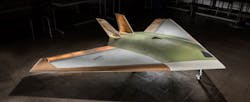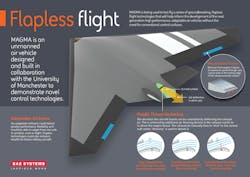Modern aircraft manipulate the air by changing the positions of their mechanical flaps. Angling the mechanical flaps redirects the flow of air over the wings, allowing the plane to change elevation and increase or decrease velocity. Along those lines, researchers at BAE Systems and the University of Manchester are now looking to transform how modern aircraft travel through the air.
The Magma drone aircraft was designed by BAE Systems and the University of Manchester. The aircraft will control airflow around it without any moving control surfaces by using only directed airflow to maneuver and adjust speed.
Magma Aviation Project is a new concept that will remove the complex moving parts, and reduce the weight and maintenance costs needed for aircraft to manipulate the air. As a result, aircraft will be able to travel quieter and more efficient. The project looks to accomplish this feat without any control surfaces—no ailerons, flaps, or tails.
These are the modern control surfaces used in commercial aircraft. The Magma Aviation Project looks to eliminate the need for flaps and ailerons.
Two key technologies allow the aircraft to manipulate air differently. First, the aircraft will have wing circulation control. This siphons the air from the aircraft’s jet engine and dispels it at supersonic speed through the trailing edge over the back of the wing, proving lift control. It eliminates the need for any mechanical moving surfaces. The second technological advantage is fluidic thrust vectoring. By using jets of air, the aircraft can deflect the exhaust and change the aircraft’s direction.
The test aircraft is a drone that will include stealth capabilities. The drone has a four-meter wingspan and will have a final weight of 45 kilograms when modified with integrated flow control devices.
The Magma project introduces two new ways to control air around an aircraft: wing circulation control and fluidic thrust vectoring. Both methods redirect airflow to guide the aircraft.
The first successful flight trail was achieved on December 13 of this year. Clyde Warsop, an engineering fellow at BAE Systems, said “the technologies we are developing with the University of Manchester will make it possible to design cheaper, higher-performance, next-generation aircraft.”
The next steps for the aircraft flight tests are to understand the effectiveness of the trailing edge and fluidic thrust vectoring devices, and to better discern whether the control surfaces could be reduced in size or removed. If the proof of concept is successful, it would be the first-ever use of circulation control in flight on a gas turbine aircraft and on a single engine.




